Search the Special Collections and Archives Portal
Search Results

Helldorado Parade, Las Vegas, Nevada: photographic print
Date
1910 (year approximate) to 1945 (year approximate)
Archival Collection
Description
From the Elizabeth Harrington Photograph Collection (PH-00291). Inscription with image reads: "Early Helldorado Parade down Fremont Street. Theme of float 'Old Woman in a Shoe'. Small girl sitting near the far left with bow in her hair is Janice Harrington, daughter of Mr. And Mrs. John Harrington. Others not identified." - E(lizabeth) Harrington (Photo by Western Studio, Las Vegas, Nev.) "Western Studio 227 South Fifth Te 825 Las Vegas, Nevada Original owener and photographer Ray E. Vincent" stamp on verso.
Image
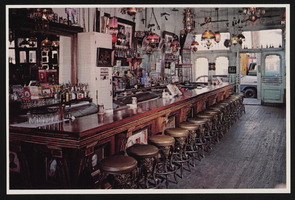
The Bucket of Blood Saloon in Virginia City, Nevada: postcard
Date
1940 (year approximate) to 1990 (year approximate)
Archival Collection
Description
From the Harvey's Hotel and Casino Postcard Collection (PH-00367) -- Interior view of the Bucket of Blood Saloon in Virginia City, Nevada. Inscription with the image says, "The interior of the Bucket of Blood Saloon is in stark contrast to the sinister name it bears. Like so many of Virginia City's famous landmarks, it was rebuilt in 1876 after being destroyed by fire. In a mixture of the old and new, it has many lovely hanging lamps and mirrors of the early era. A portrait of Sandy and Eilley Bowers, that they brought back from their tour of Europe, is proudly displayed with other mementos of the past."
Image
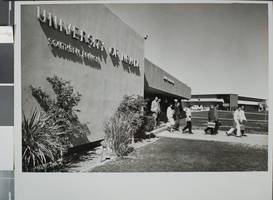
Slide of Frazier Hall, University of Nevada, Las Vegas, circa 1957
Date
1957
Archival Collection
Description
Students exiting Maude Frazier Hall at Nevada Southern University (later University of Nevada, Las Vegas).
Image
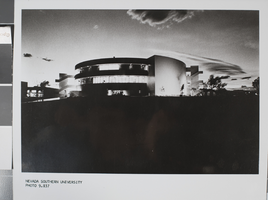
Photograph of Library at University of Nevada, Las Vegas, circa 1960s-1970s
Date
1960 to 1979
Archival Collection
Description
The Nevada Southern University (NSU), later renamed the University of Nevada, Las Vegas (UNLV), library at dusk.
Image
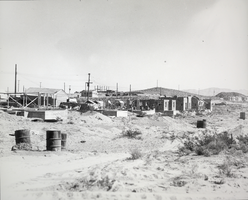
Photograph of early Boulder City, Nevada, October 12, 1931
Date
1931-10-12
Archival Collection
Description
The grayscale view of some of the first buildings in Boulder City, Nevada. Other buildings under construction can be seen among the finished buildings.
Image
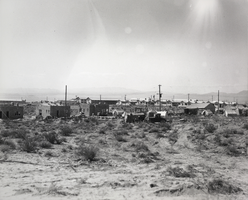
Photograph of construction in Boulder City, Nevada, October 12, 1931
Date
1931-10-12
Archival Collection
Description
The grayscale view of some of the first buildings in Boulder City, Nevada. Other buildings under construction can be seen among the finished buildings.
Image
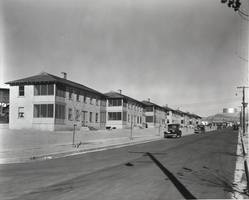
Photograph of a street scene, Boulder City, Nevada, circa 1931
Date
1930 to 1932
Archival Collection
Description
The grayscale view of dormitories built for the workers of Hoover Dam in Boulder City, Nevada. Automobiles can be seen parked alongside the adjacent road.
Image
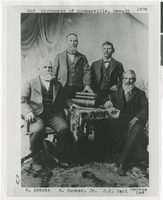
Photograph of Second (2nd) Bishopric of Bunkerville, Nevada, 1906
Date
1906
Archival Collection
Description
The Second (2nd) Bishopric of Bunkerville, Nevada. From left to right, the individuals identified are: M. Abbot; E. Bunker, Jr.; J. I. Earl; and George Lee.
Image
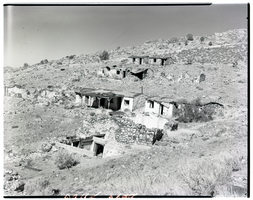
Film transparency of a ghost town, Delamar, Nevada, 1956
Date
1956
Archival Collection
Description
A view of some of the abandonded buildings on a hillside in Delamar, Nevada. One of the structures has a covered porch Delamar, Nevada, nicknamed The Widowmaker, is a ghost town in central eastern Nevada, USA along the east side of the Delamar Valley. During its heyday, primarily between 1895 and 1900, it produced $13.5 million in gold. In 1889, prospectors John Ferguson and Joseph Sharp discovered gold around Monkeywrench Wash. A mining camp was then born west of the Monkeywrench Mine. It was called Ferguson. In April 1894, Captain Joseph Raphael De Lamar bought most of the important mines in the area and renamed the Ferguson camp as Delamar. In the same year, a newspaper called the Delamar Lode began publication and a post office was opened. Soon, the new settlement boasted more than 1,500 residents, a hospital, an opera house, churches, a school, several businesses and saloons. Most buildings were made of native rock. By 1896, the Delamar mill was handling up to 260 tons of ore daily. Water for the camp was pumped from a well in Meadow Valley Wash, some twelve miles away. Supplies and materials traveled even further, by mule team over mountainous terrain from the railroad head at Milford, Utah, which was 150 miles from Delamar. Silicosis The gold in the Delamar mines was embedded in quartzite which when crushed created a fine dust. Miners breathing the dust often developed silicosis and the town became known as a "widow-maker." Many ruins now stand semi-intact in the Delamar ghost town region. Foundations can easily be seen from adjacent hills. There are two graveyards, which have been vandalized. The area is honeycombed with mines and mineshafts, but in recent years the main shaft has been blasted closed. Wild horses roam the area. The nearby dry lake is known to pilots as Texas Lake because its outline resembles the state of Texas.
Image
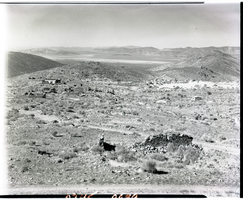
Film transparency of a ghost town, Delamar, Nevada, 1956
Date
1956
Archival Collection
Description
A view of some of the abandonded buildings in Delamar, Nevada, taken from a nearby hill. Delamar, Nevada, nicknamed The Widowmaker, is a ghost town in central eastern Nevada, USA along the east side of the Delamar Valley. During its heyday, primarily between 1895 and 1900, it produced $13.5 million in gold. In 1889, prospectors John Ferguson and Joseph Sharp discovered gold around Monkeywrench Wash. A mining camp was then born west of the Monkeywrench Mine. It was called Ferguson. In April 1894, Captain Joseph Raphael De Lamar bought most of the important mines in the area and renamed the Ferguson camp as Delamar. In the same year, a newspaper called the Delamar Lode began publication and a post office was opened. Soon, the new settlement boasted more than 1,500 residents, a hospital, an opera house, churches, a school, several businesses and saloons. Most buildings were made of native rock. By 1896, the Delamar mill was handling up to 260 tons of ore daily. Water for the camp was pumped from a well in Meadow Valley Wash, some twelve miles away. Supplies and materials traveled even further, by mule team over mountainous terrain from the railroad head at Milford, Utah, which was 150 miles from Delamar. Silicosis The gold in the Delamar mines was embedded in quartzite which when crushed created a fine dust. Miners breathing the dust often developed silicosis and the town became known as a "widow-maker." Many ruins now stand semi-intact in the Delamar ghost town region. Foundations can easily be seen from adjacent hills. There are two graveyards, which have been vandalized. The area is honeycombed with mines and mineshafts, but in recent years the main shaft has been blasted closed. Wild horses roam the area. The nearby dry lake is known to pilots as Texas Lake because its outline resembles the state of Texas.
Image
Pagination
Refine my results
Content Type
Creator or Contributor
Subject
Archival Collection
Digital Project
Resource Type
Year
Material Type
Place
Language
Records Classification
